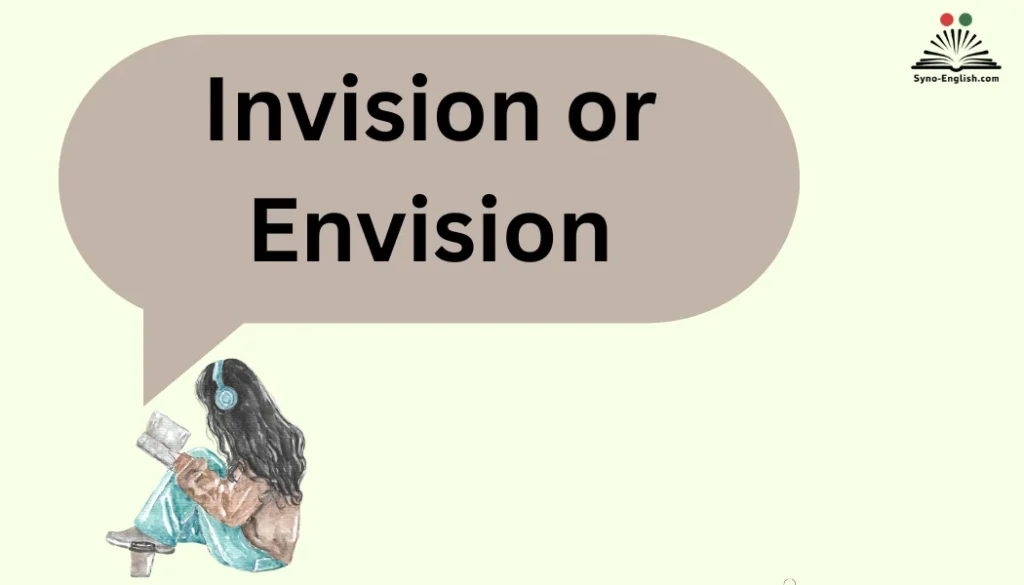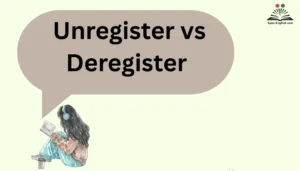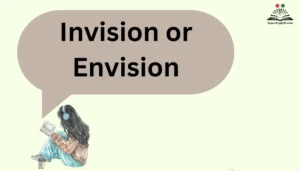In English, it’s often tricky to choose the right spelling when words sound almost identical. The topic of Invision or Envision often comes up when people mistake one for the other, and I’ve seen many learners typing the wrong version. Although both look correct, in formal writing only one is accepted.
From experience, students, professional writers, and even enthusiasts sometimes imagine a vision or creative idea but forget the proper word form.This article explores the difference between both spellings and their origins in the language.
The confusion persists as different dialects treat them uniquely, while learners often rely on sound rather than accuracy. Once you understand where a word comes from and why one form is preferred, it becomes much easier to avoid common errors and use the correct one naturally.
Invision vs Envision: Clearing Up the Confusion
Let’s start with the simple truth: only “envision” is a valid word in English.
- Envision means to imagine, picture, or foresee something in your mind.
- Invision is a common misspelling that sneaks into writing because of how the word sounds.
Think about how you pronounce it. When you say envision quickly, your ear often hears the “en” as “in.” This auditory trick explains why even skilled writers occasionally slip up.
Here’s a quick reference table:
| Word | Status | Meaning |
| Envision | ✅ Correct | To imagine or picture something clearly in the mind. |
| Invision | ❌ Incorrect | Misspelling, except when referring to the brand InVision. |
Example of correct usage:
- She envisions herself leading a global team one day.
Incorrect usage (common mistake):
- She invisions herself leading a global team one day.
The Historical Roots of “Envision”
Words carry history in their spelling. Envision traces back to the French verb “envisager”, which means to face or to contemplate. The prefix “en-” in French often means to cause to be or to put into. When paired with “vision,” the word conveys the idea of creating vision.
Timeline of the word “Envision”:
- 1600s–1700s: Early English usage leaned on envisage, meaning to look at closely or face directly.
- Late 19th century: Envision appeared in American English, influenced by shifts in spelling and simplification.
- 20th century onward: Envision gained dominance, especially in American writing, to describe mental imagery and future planning.
Unlike some words that evolved with dual spellings (like color vs colour), invision never developed as a recognized variant. It remained a phonetic error rather than a legitimate form.
Language Evolution and Spelling Mistakes
English is notorious for its irregularities. That’s why even native speakers stumble on spelling. The confusion between invision and envision fits a broader pattern.
Consider these common errors:
- Definately instead of definitely
- Alot instead of a lot
- Febuary instead of February
The same mental shortcuts apply. We write what we hear, not what dictionaries confirm.
Spellcheck doesn’t always catch invision because it might pass in branded contexts. For example, InVision, the design software, pops up in searches. That makes users second-guess whether it could also be correct in standard English.
Why this matters:
- Misspelling can undermine professional credibility.
- Search engines and grammar tools may interpret invision as a proper noun, not a spelling error.
- In academic writing, such mistakes weaken authority and accuracy.
Correct Usage in American vs British English
Both American and British English recognize only “envision.” Yet the word frequency and preference shift slightly.
- American English: Uses envision widely, especially in business, leadership, and innovation contexts. Example: “The company envisions rapid growth over the next decade.”
- British English: Sometimes favors visualize instead. Example: “She visualizes herself completing the marathon.”
Quick comparison of usage preferences:
| Dialect | Preferred Word | Example Sentence |
| American English | Envision | He envisions a future driven by renewable energy. |
| British English | Visualize | She visualizes the project’s success in fine detail. |
Both words overlap in meaning, but envision often implies future-oriented thinking, while visualize focuses on creating a mental picture.
Why “Invision” Persists
Despite being wrong in English, invision keeps showing up. Why?
- Phonetics – The “en” sound often resembles “in,” especially in fast speech.
- Brand influence – InVision, a popular digital design tool, normalizes the spelling in tech spaces.
- Digital reinforcement – Google auto-complete, domain names, and social media hashtags propagate the error.
- Cognitive bias – People assume “in-” is correct since many English words begin with that prefix (like inspire, include, invent).
A memory trick to avoid the error:
Think of “envision” as enabling vision. The “en-” helps you remember its link to creating or imagining vision.
Practical Guidance: How to Use “Envision” Correctly
Mastering usage requires practice. Below are practical examples to guide your writing:
Business context:
- Our CEO envisions expanding into international markets.
Academic context:
- Researchers envision a breakthrough in renewable technology.
Personal context:
- I envision traveling the world after retirement.
Common collocations with “envision”:
- Envision a future
- Envision success
- Envision possibilities
- Envision change
- Envision growth
Quick test – Which is correct?
- She invisions herself giving the keynote address.
- She envisions herself giving the keynote address.
Answer: Sentence 2 is correct.
Expanding Your Vocabulary: Alternatives to “Envision”
To avoid repetition and sharpen your writing, you can swap in synonyms. Each has its own nuance.
| Synonym | Nuance | Example Sentence |
| Imagine | General, everyday use | I imagine summer will be busy this year. |
| Visualize | Mental imagery, detailed | He visualized crossing the finish line. |
| Foresee | Predictive, often analytical | Experts foresee economic recovery. |
| Picture | Informal, conversational | Can you picture living by the ocean? |
| Conceive | More abstract, intellectual | Philosophers conceive ideas beyond daily life. |
Case study:
In motivational speaking, Tony Robbins often uses envision to encourage people to craft a mental picture of their goals. Yet in sports psychology, coaches lean toward visualize, urging athletes to replay movements in the mind. This distinction highlights how word choice reflects the setting and intention.
Summary & Key Takeaways
- Envision is always correct in English.
- Invision is never correct, except as a brand name.
- Both American and British English accept envision, but Brits may use visualize more often.
- Remember the root: en- means “to cause or make.” So you envision when you create vision in your mind.
- Use synonyms like visualize, imagine, foresee, or picture to expand your writing.
Quote to remember:
“The future belongs to those who can envision it before it arrives.”
So next time you catch yourself typing invision, stop and correct it. With consistent practice, you’ll avoid the mistake and strengthen your communication.
Conclusion
Understanding the difference between Invision and Envision is more than a matter of spelling—it reflects precision in language, clarity, and communication. Many learners and even professionals mix them up because both sound identical. However, while invision might appear correct, it’s envision that truly fits within formal and standard English usage. Recognizing this helps avoid common errors and builds confidence in both written and spoken communication. By knowing the origins, meanings, and proper context, you strengthen your vocabulary and ensure your message remains professional and polished.
To truly master such distinctions, consistent practice, reading, and awareness are key. As writers, students, or language enthusiasts, focusing on subtle spelling differences sharpens your eye for accuracy. Using reliable resources, consulting guides, and observing dialects can also deepen understanding. Over time, this awareness not only improves your writing but also your ability to communicate ideas clearly. The journey toward linguistic precision is gradual yet rewarding—proof that every word, even those that seem identical, holds its own distinct power in shaping meaning.
FAQs
What is the correct spelling—Invision or Envision?
The correct spelling is Envision; “Invision” is a common mistake in English.
Why do people confuse these words?
Because they sound identical, people often type “Invision” incorrectly.
Is Invision ever acceptable?
No, “Invision” isn’t accepted in formal writing or standard English.
How can I remember the correct spelling?
Think of “Envision” as related to vision or imagination.
Does pronunciation differ between dialects?
Not much—most dialects pronounce them the same way.
Are there synonyms for Envision?
Yes—imagine, visualize, conceive, or picture something.
Why is formal spelling important?
It shows professionalism, clarity, and attention to detail.
What causes spelling confusion?
Similar sounds, limited reading, and poor practice habits.
How can students improve spelling accuracy?
By using guides, resources, and daily practice.
What’s the benefit of learning correct usage?
It boosts your confidence, writing skills, and communication clarity.

Emma Brooke is a passionate English educator, writer, and language enthusiast with over a decade of experience helping learners master the nuances of the English language. At SynoEnglish, she blends practical grammar advice with real-world communication tips to make English easier, clearer, and more enjoyable for readers of all levels.



